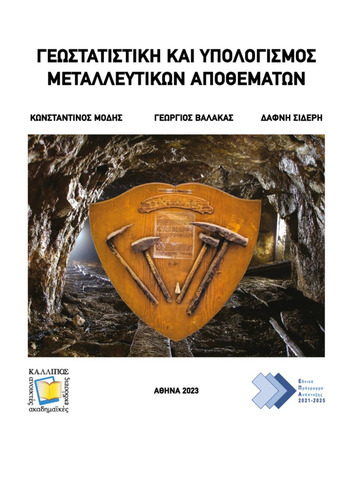| Title Details: | |
|
Geostatistics and Ore Reserves Estimation |
|
| Authors: |
Modis, Konstantinos Valakas, Georgios Sideri, Daphne |
| Subject: | NATURAL SCIENCES AND AGRICULTURAL SCIENCES > EARTH SCIENCES > GEOGRAPHY > NATURAL RESOURCES NATURAL SCIENCES AND AGRICULTURAL SCIENCES > EARTH SCIENCES > GEOGRAPHY > GEO-INFORMATICS NATURAL SCIENCES AND AGRICULTURAL SCIENCES > EARTH SCIENCES > GEOGRAPHY > GEO-INFORMATICS > SPATIAL ANALYSIS NATURAL SCIENCES AND AGRICULTURAL SCIENCES > EARTH SCIENCES > GENERAL GEOLOGY > MATHEMATICAL GEOLOGY ENGINEERING AND TECHNOLOGY > TECHNOLOGICAL SCIENCES AND ENGINEERING > MINING AND METALLURGICAL TECHNOLOGY AND ENGINEERING > COAL, LIGNITE AND RADIOACTIVE ORES MINING ENGINEERING AND TECHNOLOGY > TECHNOLOGICAL SCIENCES AND ENGINEERING > MINING AND METALLURGICAL TECHNOLOGY AND ENGINEERING > MINES ENGINEERING AND TECHNOLOGY > TECHNOLOGICAL SCIENCES AND ENGINEERING > MINING AND METALLURGICAL TECHNOLOGY AND ENGINEERING > MINING RESEARCH ENGINEERING AND TECHNOLOGY > TECHNOLOGICAL SCIENCES AND ENGINEERING > MINING AND METALLURGICAL TECHNOLOGY AND ENGINEERING > ROCK MECHANICS |
| Keywords: |
Estimation
Spatial modelling Simulation Kriging Risk assesment Mineral exploration Mine planning |
| Description: | |
| Abstract: |
Geostatistics, according to the definition of its founder, G. Matheron, is an application of the theory of Random Functions (RF) in Geosciences. Its goal is the development of efficient interpolation algorithms for the creation of 3D maps of the variable of interest. The aim of the book is to introduce the readers to the basic concepts of Geostatistics and its application to Mineral Exploration problems, the most important being the calculation of reserves of a mineral deposit. In particular, the basic statistical concepts and the corresponding analysis of exploration data for the estimation of ore reserves are included, with reference to the sampling methods and the relative errors introduced by them. The concepts of RF and Regionalized Variables, as well as stochastic estimation in general, are presented in a simplified way. This is followed by an introduction to the tools of spatial analysis, variograms and covariance functions. Kriging algorithms are presented to estimate the features at unsampled locations, based on the available borehole samples. Reference is made to estimation errors and cross-validation methods. This is followed by an introduction to the concept and methods of stochastic simulation as an alternative to estimation, in cases where it is desirable to examine different scenarios for the economic evaluation of the investment. The previous methods are then applied to the spatial mapping of the geotechnical parameters of the deposit and the surrounding formations. The prevailing reserves classification systems and the way to calculate the parameters required to characterize the orebody according to them are described. Finally, enough case studies are presented for all the topics of the book. In most of them, the original data is also available, so that there is the possibility of practicing using programs in R language, which are also available on the Internet.
|
| Linguistic Editors: |
Oxenkioun, Eleni Elissavet |
| Graphic Editors: |
Stavrianou, Irini |
| Type: |
Undergraduate textbook |
| Creation Date: | 18-04-2023 |
| Item Details: | |
| ISBN |
978-618-5726-77-5 |
| License: |
Attribution - NonCommercial - ShareAlike 4.0 International (CC BY-NC-SA 4.0) |
| DOI | http://dx.doi.org/10.57713/kallipos-203 |
| Handle | http://hdl.handle.net/11419/9348 |
| Bibliographic Reference: | Modis, K., Valakas, G., & Sideri, D. (2023). Geostatistics and Ore Reserves Estimation [Undergraduate textbook]. Kallipos, Open Academic Editions. https://dx.doi.org/10.57713/kallipos-203 |
| Language: |
Greek |
| Consists of: |
1. Introduction and basic concepts of ore reserves estimation 2. Basic statistical concepts and exploration data analysis 3. Sampling and errors 4. The stochastic estimation model 5. Variograms and structural analysis of a RF 6. Theoretical models of variograms and their adaptation 7. Estimation and kriging algorithms 8. Estimation error and cross-validation 9. Introduction to simulation 10. Mapping of geotechnical parameters 11. Classification of mineral resources and ore reserves 12. Case studies |
| Number of pages |
330 |
| Publication Origin: |
Kallipos, Open Academic Editions |
| You can also view | |
| User comments | |
There are no published comments available! | |

